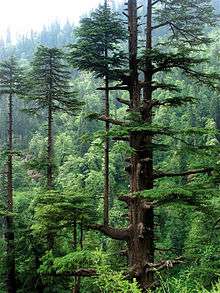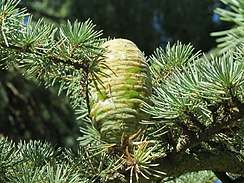Cedrus deodara
Cedrus deodara, the deodar cedar, Himalayan cedar, or deodar/ devdar/ devadar/ devadaru, is a species of cedar native to the western Himalayas in Eastern Afghanistan, Northern Pakistan (especially in Khyber Pakhtunkhwa) and India (Jammu and Kashmir, Himachal Pradesh, Uttarakhand, Sikkim and, Arunachal Pradesh states and the Darjeeling Region of West Bengal), Southwestern Tibet and Western Nepal, occurring at 1,500–3,200 m (4,921–10,499 ft) altitude.
| Deodar cedar | |
|---|---|
 | |
| Adult Deodar trees in Himachal Pradesh, India | |
| Scientific classification | |
| Kingdom: | Plantae |
| Clade: | Tracheophytes |
| Division: | Pinophyta |
| Class: | Pinopsida |
| Order: | Pinales |
| Family: | Pinaceae |
| Genus: | Cedrus |
| Species: | C. deodara |
| Binomial name | |
| Cedrus deodara | |
Description
It is a large evergreen coniferous tree reaching 40–50 m (131–164 ft) tall, exceptionally 60 m (197 ft) with a trunk up to 3 m (10 ft) in diameter. It has a conic crown with level branches and drooping branchlets.[2]
The leaves are needle-like, mostly 2.5–5 cm (0.98–1.97 in) long, occasionally up to 7 cm (2.8 in) long, slender (1 mm (0.039 in) thick), borne singly on long shoots, and in dense clusters of 20–30 on short shoots; they vary from bright green to glaucous blue-green in colour. The female cones are barrel-shaped, 7–13 cm (2.8–5.1 in) long and 5–9 cm (2.0–3.5 in) broad, and disintegrate when mature (in 12 months) to release the winged seeds. The male cones are 4–6 cm (1.6–2.4 in) long, and shed their pollen in autumn.[2]
Etymology
The botanical name, which is also the English common name, derives from the Sanskrit term devadāru, which means "wood of the gods", a compound of deva "god" and dāru "wood and tree".
Cultural importance in the Indian subcontinent
Among Hindus, as the etymology of deodar suggests, it is worshiped as a divine tree. Deva, the first half of the Sanskrit term, means divine, deity, or deus. Dāru, the second part, is cognate with (related to) the words durum, druid, tree, and true.[3]
Several Hindu legends refer to this tree. For example, Valmiki Ramayan – Kishkinda khanda- stanza 4-43-13 reads:[4]
lodhra padmaka khaNDeSu devadaaru vaneSu ca |
raavaNaH saha vaidehyaa maargitavyaa tataH tataH || || 4-43-13
That means “In the stands of Lodhra trees,[5] Padmaka trees [6] and in the woods of Devadaru, or Deodar trees, Ravana is to be searched there and there, together with Sita. [4-43-13]”
Forests full of Deodar or Devadāru trees were the favorite living place of ancient Indian sages and their families who were devoted to the Hindu god Shiva. To please Lord Shiva, the sages used to perform very difficult tapasya (meditation) practices in deodar forests. Also the ancient Hindu epics and Shaivite texts regularly mention Darukavana, meaning a forest of deodars, as a sacred place.
Cultivation
It is widely grown as an ornamental tree, often planted in parks and large gardens for its drooping foliage. General cultivation is limited to areas with mild winters, with trees frequently killed by temperatures below about −25 °C (−13 °F), limiting it to USDA zone 7 and warmer for reliable growth.[8] It can succeed in rather cool-summer climates, as in Stateline, Nevada, and Ushuaia, Argentina.[9]

The most cold-tolerant trees originate in the northwest of the species' range in Kashmir and Paktia Province, Afghanistan. Selected cultivars from this region are hardy to USDA zone 7 or even zone 6, tolerating temperatures down to about −30 °C (−22 °F).[8] Named cultivars from this region include 'Eisregen', 'Eiswinter', 'Karl Fuchs', 'Kashmir', 'Polar Winter', and 'Shalimar'.[10][11] Of these, 'Eisregen', 'Eiswinter', 'Karl Fuchs', and 'Polar Winter' were selected in Germany from seed collected in Paktia; 'Kashmir' was a selection of the nursery trade, whereas 'Shalimar' originated from seeds collected in 1964 from Shalimar Gardens, India (in the Kashmir region) and propagated at the Arnold Arboretum.[10]
C. deodara,[12] and the two cultivars ‘Feelin’ Blue’[13] and ‘Aurea’,[14] have gained the Royal Horticultural Society’s Award of Garden Merit (confirmed 2017).[15]
Uses
Construction material

Deodar is in great demand as building material because of its durability, rot-resistant character and fine, close grain, which is capable of taking a high polish. Its historical use to construct religious temples and in landscaping around temples is well recorded. Its rot-resistant character also makes it an ideal wood for constructing the well-known houseboats of Srinagar, Kashmir. In Pakistan and India, during the British colonial period, deodar wood was used extensively for construction of barracks, public buildings, bridges, canals and railway cars.[3] Despite its durability, it is not a strong timber, and its brittle nature makes it unsuitable for delicate work where strength is required, such as chair-making.
Herbal Ayurveda
C. deodara is used in Ayurvedic medicine.[3]
The inner wood is aromatic and used to make incense. Inner wood is distilled into essential oil. As insects avoid this tree, the essential oil is used as insect repellent on the feet of horses, cattle and camels. It also has antifungal properties and has some potential for control of fungal deterioration of spices during storage. The outer bark and stem are astringent.[16]

Because of its antifungal and insect repellent properties, rooms made of deodar cedar wood are used to store meat and food grains like oats and wheat in Shimla, Kullu, and Kinnaur district of Himachal Pradesh.
Cedar oil is often used for its aromatic properties, especially in aromatherapy. It has a characteristic woody odor which may change somewhat in the course of drying out. The crude oils are often yellowish or darker in color. Its applications cover soap perfumes, household sprays, floor polishes and insecticides and is also used in microscope work as a clearing oil.[16]
Chemistry
The bark of Cedrus deodara contains large amounts of taxifolin.[17] The wood contains cedeodarin, ampelopsin, cedrin, cedrinoside,[18] and deodarin (3′,4′,5,6-tetrahydroxy-8-methyl dihydroflavonol).[19] The main components of the needle essential oil include α-terpineol (30.2%), linalool (24.47%), limonene (17.01%), anethole (14.57%), caryophyllene (3.14%), and eugenol (2.14%).[20] The deodar cedar also contains lignans[21] and the phenolic sesquiterpene himasecolone, together with isopimaric acid.[22] Other compounds have been identified, including (−)-matairesinol, (−)-nortrachelogenin, and a dibenzylbutyrolactollignan (4,4',9-trihydroxy-3,3'-dimethoxy-9,9'-epoxylignan).[23]
See also
References
- Farjon, A. (2013). "Cedrus deodara". IUCN Red List of Threatened Species. IUCN. 2013: e.T42304A2970751. doi:10.2305/IUCN.UK.2013-1.RLTS.T42304A2970751.en.
- Aljos, Farjon (1990). Pinaceae: drawings and descriptions of the genera Abies, Cedrus, Pseudolarix, Keteleeria, Nothotsuga, Tsuga, Cathaya, Pseudotsuga, Larix and Picea. Koenigstein: Koeltz Scientific Books. ISBN 978-3-87429-298-6.
- McGowan, Chris (March 5, 2008). "The Deodar Tree: the Himalayan 'Tree of God'".
- "ValmikiRamayan".
- Symplocos racemosa
- Wild Himalayan Cherry
- "Pakistan". Archived from the original on 2016-11-28.
- Ødum, S. (1985). Report on frost damage to trees in Denmark after the severe 1981/82 and 1984/85 winters. Denmark: Hørsholm Arboretum.
- http://treesneartheirlimits.blogspot.ca/
- Humphrey James, Welch (1993). Haddows, Gordon (ed.). The World Checklist of Conifers. Bromyard: Landsman's Bookshop. ISBN 978-0-900513-09-1.
- Gerd, Krüssmann (1983). Handbuch der Nadelgehölze (in German) (2nd ed.). Berlin: Parey. ISBN 978-3-489-62622-0.
- "RHS Plantfinder - Cedrus deodar". Royal Horticultural Society. Retrieved 21 January 2018.
- "RHS Plantfinder - Cedrus deodara 'Feelin' Blue'". Royal Horticultural Society. Retrieved 21 January 2018.
- "RHS Plantfinder - Cedrus deodara 'Aurea'". Royal Horticultural Society. Retrieved 21 January 2018.
- "AGM Plants - Ornamental" (PDF). Royal Horticultural Society. July 2017. p. 16. Retrieved 24 January 2018.
- "Cedarwood Oils". Flavours and fragances of plant origin. Food and Agriculture Organization of the United Nations. 1995. ISBN 92-5-103648-9.
- Willför, Stefan; Ali, Mumtaz; Karonen, Maarit; Reunanen, Markku; Arfan, Mohammad; Harlamow, Reija (2009). "Extractives in bark of different conifer species growing in Pakistan". Holzforschung. 63 (5): 551–8. doi:10.1515/HF.2009.095.
- Agrawal, P.K.; Agarwal, S.K.; Rastogi, R.P. (1980). "Dihydroflavonols from Cedrus deodara". Phytochemistry. 19 (5): 893–6. doi:10.1016/0031-9422(80)85133-8.
- Adinarayana, D.; Seshadri, T.R. (1965). "Chemical investigation of the stem-bark of Cedrus deodara". Tetrahedron. 21 (12): 3727–30. doi:10.1016/S0040-4020(01)96989-3.
- Zeng, Wei-Cai; Zhang, Zeng; Gao, Hong; Jia, Li-Rong; He, Qiang (2012). "Chemical Composition, Antioxidant, and Antimicrobial Activities of Essential Oil from Pine Needle (Cedrus deodara)". Journal of Food Science. 77 (7): C824–9. doi:10.1111/j.1750-3841.2012.02767.x. PMID 22757704.
- Agrawal, P.K.; Rastogi, R.P. (1982). "Two lignans from Cedrus deodara". Phytochemistry. 21 (6): 1459–1461. doi:10.1016/0031-9422(82)80172-6.
- Agarwal, P.K.; Rastogi, R.P. (1981). "Terpenoids from Cedrus deodara". Phytochemistry. 20 (6): 1319–21. doi:10.1016/0031-9422(81)80031-3.
- Tiwari, AK; Srinivas, PV; Kumar, SP; Rao, JM (2001). "Free radical scavenging active components from Cedrus deodara". Journal of Agricultural and Food Chemistry. 49 (10): 4642–5. doi:10.1021/jf010573a. PMID 11600001.
External links
| Wikimedia Commons has media related to Cedrus deodara. |
